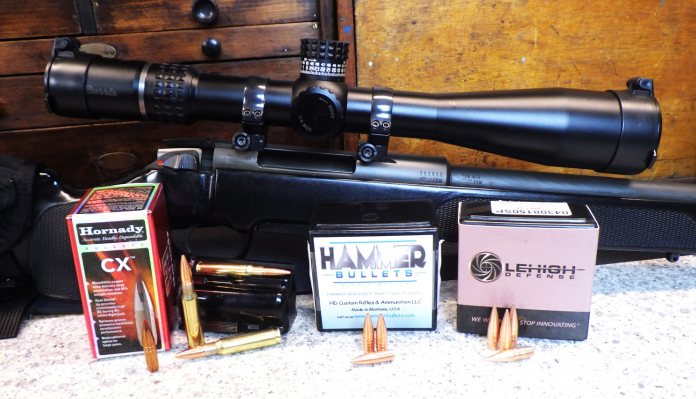Reloading Basics - For your consideration
-
0
 Comments
Comments
- Last updated: 09/04/2024

Advances in bullet design, and the ever-growing pressure to move away from lead-cored bullets, are happening faster than ever and the progress shows no signs of going away. Bullets are becoming longer, ogives are flattening out, and bullets that do not have a lead core have the more traditional and familiar bullet weights getting longer. Modern bullets tend to have better ballistic coefficients, which improves accuracy, and for long-range shooting, they produce better and better results on the target.
For those of us who reload, these changes give rise to issues in both the way we reload them and the powder charge we put behind them. In addition to the requirement to accommodate the increased bullet length somewhere within your reloads, longer bullets invariably have larger bearing surfaces which also generates several potential issues that also have to be considered.
The long game
The range of lead-free projectiles seems to be growing every day, with some fantastic bullets available from top manufacturers like Hornady, Hammer, and Lehigh Defence. Of course, there is also factory ammunition which incorporates the newer type of bullets, from companies like Barnes and Sellier & Bellot. All of these monolithic bullets share several common features that make them different from the lead options.
Because the monolithic bullets have a larger bearing surface, there is the potential for them to generate significantly increased friction as they travel up the barrel. They are also harder than bullets with a lead core, so they are far less willing to obturate and ‘give’ a little as they are shaped and squashed into the rifling. These factors will contribute to increased chamber pressure. To address this issue, the bullet manufacturers are putting deep grooves around the shank of the bullets to reduce the bearing surface and increase the effectiveness of the rifling.
Monolithic bullets are longer because they are made of lighter materials than lead, and this results in a shift in the projectile’s centre of gravity towards its rear. This can mean that, while a lead-core bullet of a particular weight works fine in your rifle, a longer lead-free bullet of the same weight will not stabilise in the twist rate of your gun. To counter this loss of stability and accuracy, you may have to shift to a lighter monolithic bullet. Any potential reduction in terminal performance associated with such a movement down in weight will usually be mitigated by the improvement in the performance of the modern bullets.
Reloading data for new bullets
Whenever possible, specific reloading data should be used for each particular bullet. What you definitely should not do is simply substitute a longer bullet for a shorter one and keep all other components in your loads the same.
Fortunately, most bullet manufacturers are very good at responding to customers’ questions. So, if you cannot find reloading data for a new bullet, it is definitely worth dropping them an email. Failing that, reloading software tends to be regularly updated to include new products and loads, and QuickLOAD already has data for the latest Hammer and Hornady bullets included. With this type of software, you can easily check out a load and substitute a new bullet into your existing recipe to see the effects it has.
Reloading issues
The longer bullets can make it difficult to adhere to the Cartridge Overall Length (COL) stated in the reloading data, and seating them too deeply to meet the COL will cause issues. Firstly, the case mouth can be in contact with the ogive of the bullet, rather than the shank, and this will cause inconsistent neck tension. Secondly, if more of the bullet is seated inside the case, there will be less space for the gases generated to expand when the powder is burnt, and this will increase the chamber pressure. It is therefore necessary to seat the bullets further out, so the case mouth sits on the shank, although this may result in you exceeding the stated COL. If this is the case, you then need to check that the bullet is not coming into contact with the lands of the rifling because this can generate higher and potentially dangerous chamber pressure. Once you have established a safe COL, you need to check that the cartridge will fit into, and feed from, the rifle’s magazine. The COL needs to be carefully adjusted to take into consideration all of these factors. (See Table)
Another potential issue with these new bullets is that your standard bullet seating plug may not properly fit the meplat (bullet tip), resulting in damage that will affect performance. You should check the fit and change the plug if necessary. Very Low Drag (VLD) seating plugs can be purchased to suit many of these bullets.
Obviously, the powder charge is one of the most critical elements of ammunition and when considering longer bullets, adjustments must be made. Both the additional amount of bullet seated inside the case and the increased friction between the bullet and the bore will increase the chamber pressure. Combined, they can take that pressure to dangerous levels. This is why you have to back the powder charge off and use proper reloading data for the bullet you are using.
Conclusion
Although you can take full advantage of these new bullet designs and incorporate them into your reloads relatively easily, it is not a simple case of ‘plug and play’ i.e. you cannot just replace a lead-cored bullet with a monolithic bullet of the same weight. Part of reloading is fully understanding the limitations and characteristics of each component and staying within safe limits to avoid causing a potentially dangerous situation.
